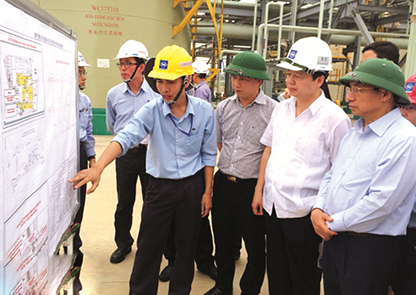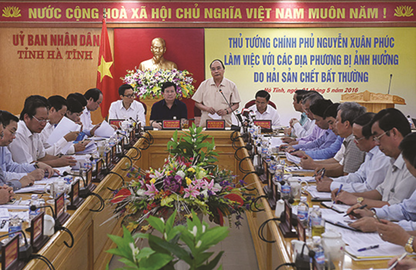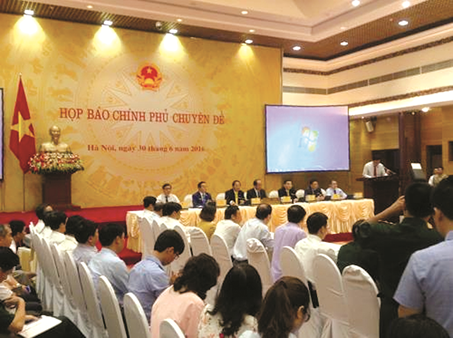

10/10/2016
An abnormal fish death incident started on 6th April 2016 in Hà Tĩnh and then spread to Quảng Bình on 10th April 2016, Thừa Thiên Huế on 15th April 2016 and Quảng Trị on 16th April 2016. From 4th to 7th May 2016, the fish death incident declined with some dead fish was observed in Cửa Tùng, Quảng Trị. From 8th May 2016 to present, the dead fish incident has stopped. Also during this period, many environmental pollution cases happened in other localities nationwide, attracting public interest and causing social outrage.
 |
| Minister Trần Hồng Hà (second from right) heads a taskforce in investigating the mass dead fish (Source: Hà Tĩnh Newspaper) |
To follow directives by Prime Minister, competent authorities have taken serious actions to identify causes and culprits based on scientific evidence, legal foundation and international practices. Measures taken include involving a large number of scientists and leading experts, regularly updating situations from the sites, collecting samples and retrieving information on natural conditions at the sites, analyzing meteorological data, maritime currents, remote sensing, and applying maritime pollution diffusion modelling to retrieve pollution sources. In addition, dead fish and sediment samples were collected and analyzed with advice from international scientists in methodology and analyses to increase objectiveness and reliability of the findings.
Ministry of Science and Technology (MOST) has collaborated with Viet Nam Academy of Science and Technology (VAST), Ministry of Natural Resources and Environment (MONRE) and other related Ministries to establish a national council of science and technology with participants of more than 100 scientists from over 30 research institutions and universities. Task forces have been developed to be on call in the four provinces to cooperate with ministries, sectors and localities to investigate, take and analyze samples and solve some problems on site. Consultative meetings for scrutiny and determination of causes of the fish death were held. It was concluded that toxic chemicals (phenol and cyanide) were the causes of the fish death in the four provinces. Simulation modeling, remote sensing analyses, waste audits and collected samples have proven that a large waste source from Vũng Áng (Hà Tĩnh) containing a mixture of Ferron, phenol, cyanide, heavy metals and multi cycle hydrocarbon transported along with maritime currents and caused the mass dead fish.
 |
| Prime Minister Nguyễn Xuân Phúc meets with affected localities (Source: VGP) |
MONRE cooperated with other ministries, sectors and the four coastal provinces in reviewing all major sources of waste being discharged into the sea. It was found that big waste sources were from Vũng Áng Economic Zone of Hà Tĩnh province. In the meantime, MONRE established an inter-ministerial taskforce to inspect environmental protection and water resource compliance of facilities discharging their wastes into the sea in Vũng Áng Economic Zone. The facilities include Hà Tĩnh Formosa, Hà Tĩnh Petrol Electricity Company and Hà Tĩnh Centre for Economic Zone Infrastructure. Seventy two officers, scientists, and leading experts in the fields of environment, remote sensing, hydrometeorology, oceanography, ecology, chemistry and steel production participated in the taskforce, divided into six groups which were headed by directors and deputy directors of scientific institutions. The inspection revealed that Hà Tĩnh Formosa Company had administrative violations in environmental protection and water resources. Some signs of causes of the environmental incidents were found. Taking into accounts findings from waste inventories of facilities in the four provinces from Hà Tĩnh to Thừa Thiên - Huế, MONRE determined that only wastes from Hà Tĩnh Formosa Company contained phenol and cyanide.
Based on findings of surveys and inspections, MONRE, MOST, VAST and related ministries/sectors agreed on the causes of the abnormal dead fish incident being phenol and cyanide from Hà Tĩnh Formosa Company.
Through legal arguments, Hà Tĩnh Formosa Company accepted its responsibility for the environmental incidents which caused mass dead fish in the four provinces from Hà Tĩnh to Thừa Thiên - Huế. It is also committed to: publically apologizing the Government and the people of Việt Nam for the serious environmental incident; paying the local people for the damages and occupational transfer, and paying for pollution remediation and environmental restoration in the four Central coastal provinces with a total budget of over 11,500 billion VND (500 million USD); radically addressing shortcomings and problems of the waste and waste water treatment systems, completing production technology and ensuring that all toxic agents are properly treated before being discharged into the environment as required by national and provincial environment authorities and that similar incidents will not reoccur; working with Vietnamese ministries/sectors and the Central provinces in developing comprehensive measures for maritime pollution control to prevent future incidents and to build trusts among the Vietnamese people and the international community; and fulfilling all commitments and ensuring no further environmental incidents.
Identification of causes and agents of the incidents was a result of prompt and assertive directions by the Party and State leaders and active participation of Ministries and related localities. In practice, it is usually very time consuming to detect causes and agents of similar environmental incidents, even in developed countries. In some cases, it is impossible to identify causes and culprits of the incidents.
In addition to investigation of the causes and culprits, Prime Minister issued Decision no. 772/QD-TTg dated 9th May 2016 on urgently supporting affected people in Hà Tĩnh, Quảng Bình, Quảng Trị and Thừa Thiên-Huế, Decision no. 1138/QD-TTg dated 25th June 2016 on extending supporting periods for the local farmers as stated in Decision no. 772/QD-TTg. According to these documents, supports were given to affected farmers, fishmen, aquaculture farm owners and cooperatives via disaster relief mechanisms. Each person in families of owners or workers in fishing boats received 15 kg of rice per month in six months. A lumpsum of maximum of 5 million USD was given to both on-shore and off-shore ships which had to cease operation due to the incident. Credit loans were given 100% support in fish storing enterprises from 5th May to 5th July 2016. Up to 70% of the values of the dead fish products subject to being destroyed due to safety reasons were compensated for. So far, the Government has allocated about 4,182 tons of rice from a national reserve. Vietnam Environmental Protection Fund has supported the localities to destroy the dead fish (about 4 billion VND). The Central Committee of Viet Nam Fatherland’s Front has granted over 5 billion VND for the affected farmers.
 |
| Government’s press conference on causes of abnormal fish dead incident in the four Central provinces (Source: VGP) |
Right after the fish death incident and after receiving reports from local authorities, MONRE conducted environmental monitoring in the affected areas from 21st April to 2nd May 2016. In the meantime, MONRE issued guiding documents for the four provinces from Hà Tĩnh to Thừa Thiên - Huế to conduct daily monitoring at beaches since 29th April 2016. The monitoring has been continuous and followed National Regulations on on-shore coastal water quality of beaches and water sport activities (QCVN 10-MT:2015/BTNMT). Monitoring results have been publicized daily on MONRE’s internet portal, VEA’s website and disseminated via 300 mass media agencies (Viet Nam Television, Voice of Viet Nam, People’s Newspaper, Labor’s Newspaper, and Pioneers’ Newspaper) for public access.
MONRE has mobilized all maritime environment monitoring stations of the national monitoring networks and four affected provinces in implementing a coastal onshore and offshore water quality monitoring program from Thanh Hoa to Quang Nam with maximum density and frequency as regulated in Decision no. 977/QD-BTNMT. In this program, monitoring was conducted at 50 near shore sites, 27 on shore sites and 16 off shore sites. Sediment monitoring was 14 conducted for on shore sites. Monitored parameters followed National Regulation on maritime water quality (QCVN 10-MT:2015/BTNMT) and National Regulation on Sediment Quality (QCVN 43:2012/BTNMT). Monitoring results showed that when the incident happened, some parameters such as Ferron, phenol and ammonia in on shore and near shore sea water exceeded permitted levels. However, the water quality has gradually restored. So far, most of the parameters have reached permitted levels.
At present, MONRE is implementing a program of surveying, investigating and assessing maritime pollution in the four coastal provinces. In this program, 36 marine routes were surveyed with a total 146 monitoring points of 348 km length. Subjects of the survey include water environment (surface, middle and seabed parts); sediments, maritime creatures, coral reefs, see weeds, and materials attached on coral reefs and seabeds. Survey methods include surface water survey, seabed diving survey and video recording. This program is aimed at providing further information on the state of marine environment in the four provinces so that pollution remediation and ecological restoration measures could be developed.
The mass fish dead incident in the central coastal provinces is the most serious unprecedented maritime environment incident. Initial responses appeared slow and ineffective. However, after Prime Minister and Deputy Prime Ministers had directed, the Ministries/sectors and localities took assertive, rapid, cautious, objective and scientific actions in a well-coordinated manner. With active participation of a large numbers of Government officials, experts and scientists, using theoretical approaches, remote sensing, simulation modelling, surveys, sampling, analysis, investigations of large projects and legal arguments, within nearly three months, the causes of the fish dead has been identified. Culprits have admitted the responsibilities for the incident and committed to paying compensation for damages and administrative fines. In addition to investigation for causes and culprits, the Government, Ministries/sectors and localities issued policies and taken actions to support livelihood of the local people and restore production and trade activities in the affected areas. In the meantime, MONRE closely worked with other Ministries/sectors and people’s committees in the four provinces to survey, investigate and assess pollution and damage to maritime ecological systems as well as maritime water and sediment quality. The findings were publicized. Restoration measures were taken accordingly.
After this environmental incident, we have drawn many lessons in directing and cooperating in solving intersectoral and interprovincial environmental problems, in mobilizing a large number of scientists and experts, in cooperation among Ministries and central and provincial authorities, in timely supporting affected people, in using legal arguments to urge Hà Tĩnh Formosa Company to accept their responsibilities and compensate for damages, and timely taking actions to assess the damage and restoring measures.
The mass fish dead incident in the four coastal provinces and recent environmental problems in some other hotspots in Việt Nam have resulted from rapid and unstainable development. Many localities have aimed at economic growth without due attention to environmental protection. To address the many environmental challenges at the same time requires comprehensive measures of prevention and short term and long term responses. For the time being, it is necessary to take the following measures:
Firstly, conducting pollution inventories for large emission and high risk facilities, and applying strict pollution controls (monitoring, automatic sampling, stabilizing tanks after waste treatment, and using biological indicators and automatic camera in monitoring); increasing supervision and inspection to timely detect shortcomings and environmental violation and give early warnings for environmental pollution and incidents; strictly handling environmental violations;
Secondly, strengthening capacity in monitoring and assessing the state of the environment, giving early warning and responding timely, in particular in key economic zones with many large waste sources and in environmentally sensitive areas. In addition, capacity for monitoring data analyses and information sharing mechanism should be strengthened;
Thirdly, developing and issuing protocols for responding to environmental incidents with clear responsibilities of Ministries/sectors and national and provincial authorities, with a motto “nationally coordinated and directed and locally acted”, (human resources, equipment and resources). This protocol is also applied for dealing with serious emerging environmental pollution problems;
Fourthly, seriously following the direction of sustainable development without scarifying the environment for economic growth and eradicating the thoughts of investment at all costs; developing and completing policies, regulations and technical barriers to prevent and screen outdated technologies, resources consuming and polluting projects, in particular in environmentally sensitive areas;
Fifthly, overcoming shortcomings in the state management of environmental protection, in particular applying pollution prevention and control from strategic environmental assessment, environmental impact assessment, supervision and verification of environmental protection measures, pollution source inspection and monitoring; ensuring effectiveness of these measures;
Sixthly, reviewing and improving organizational structure, strengthening capacity in environmental management at both national and local levels to meet an increasing demand for solving outbreaking environmental pollution problems.
Dr. Nguyễn Văn Tài - Director General
Vietnam Environment Administration